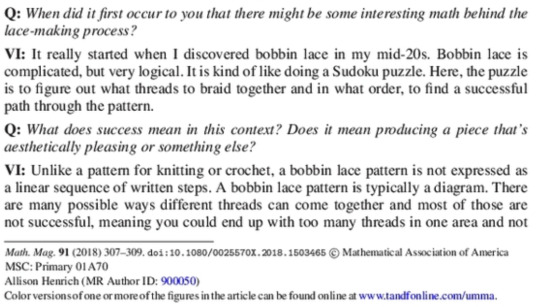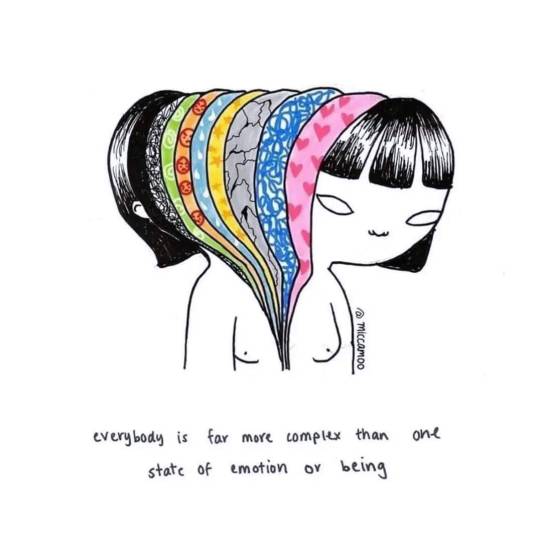#complexity
Text

I don't understand how lace is made, but looking at the bobbins and pins and patterns … listen buddy I know math when I see it. This is A Math Thing. Obviously.

Right away I want to know:
Can I encode information in lace?
How much of an expert must one be to make your own patterns?
What about the creation of surfaces?
Knitting is more accessible, and people have been exploring math with knitting forever.
But what possibilities does lace offer?
What is the theory of lace?

An excerpt from Mathematics Magazine
Vol. 91, No. 4 (October 2018), pp. 307-309
Shows I'm hardly the first person to muse about this. Need to get my hands on the rest of this article, obviously.

#crafts#crafting#making#lace#lacemaking#knitting#mathematics#topology#geometry#bobbin lace#tatted lace#tatting#complexity#patterns#industrial revolution
1K notes
·
View notes
Text

"Everything Everywhere All at Once"
Loved this movie with all my heart and still do! I will continue to post some of my old works that I originally published on instagram but soon I'll finally post some unreleased sketches.
#everything everywhere all at once#my art#fanart#digital drawing#movie#poster#hands#eeaao#complexity#confusion#paradox#multiverse#action#colorful#trippy#anatomy#perspective#goreboy_art
315 notes
·
View notes
Text



A Galaxy Within
24 x 18 in, 2019
We are each a little galaxy of our own. It's a mind-bending exercise trying to comprehend the 100 billion stars found in a typical galaxy. Yet, each of us has roughly the same number of neurons in our own brain, performing a symphony of consciousness. Similar too, is the number of atoms that write out our DNA code. We are a staggeringly complex and unique collection of natural components, come together for a short, precious moment.
Large numbers are difficult to fathom, but to be disappointed in the realization that we are “just” collections of atoms moving in accordance with the laws of physics, is to misunderstand the depth of this astonishing complexity, and the billions of years it took to evolve.
“We are the miracle, we human beings. Not a break-the-laws-of-physics kind of miracle; a miracle in that it is wondrous and amazing how such complex, aware, creative, caring creatures could have arisen in perfect accordance with those laws [of nature] … Our emergence has brought meaning and mattering into the world ... It bequeaths to us the responsibility and opportunity to make life into what we would have it be.”
-Sean Carroll, The Big Picture
The print shop is back up and running!
137 notes
·
View notes
Quote
One way of dealing with the boredom of our own needs might be to complicate them unnecessarily, so as always to have something new to desire. Human needs, Schopenhauer thought, are not in their essence complex. On the contrary, their “basis is very narrow: it consists of health, food, protection from heat and cold, and sexual gratification; or the lack of these things.” Yet on this narrow strip we build the extraordinary edifice of pleasure and pain, of hope and disappointment!
Zadie Smith, "Windows on the Will"
#needs#desires#boredom#emotions#feelings#complexity#humanity#quotes#Smith#Zadie Smith#Windows on the Will
196 notes
·
View notes
Text
You know what I absolutely love about Good Omens?
IT’S COMPLEX
The story defies categorisation/labels, tropes, and black-and-white thinking
oh, and also it makes your brain spin
#good omens#gomens#go#my two cents#i have things to say#complexity#life is complex#good omens book#good omens tv#meta post
55 notes
·
View notes
Text
We'll look later at what has ensued over the last 100 years in particular, but suffice to say, what a keen gardener knows now, they also knew in the late 1800s – that compost is king, complexity seems to create resilience, and that a well-grown vegetable tastes of the soil in which it was grown.
"Soil: The incredible story of what keeps the earth, and us, healthy" - Matthew Evans
#book quote#soil#matthew evans#nonfiction#history#gardener#gardening#1800s#19th century#soil health#compost#complexity#resilience#vegetables#quality products
66 notes
·
View notes
Quote
When an individual considers himself esthetically, he becomes conscious of this self as a complex concretion intrinsically qualified in many ways; but despite all the internal variety, all these together are nevertheless his nature, have equal right to emerge, equal right to demand satisfaction. His soul is like soil out of which grow all sorts of herbs, all with equal claim to flourish; his self consists of this multiplicity, and he has no self that is higher than this.
Søren Kierkegaard, Either/Or
#philosophy#quotes#Søren Kierkegaard#Either/Or#self#complexity#multiplicity#aesthetics#individuality
80 notes
·
View notes
Text

#abstract#art#artistic#artistic design#artwork#arty#background#beautiful artwork#beauty#color#colorful#colors#colour design#complexity#contemporary design#contemporary patterns#decoration#decorative#designer#detailed#digital art#digital arts#digital media#fractal background#fractal design#fractal geometry#fractalist#fractals#geometric#geometric abstract
38 notes
·
View notes
Text
quick thing about the nuances of desire that is often over looked, specifically in regards to touch aversion
the argument I get the most when discussing Kanej having a relationship without any physical intimacy or touch is that they both want that
but here's the thing
yes they both express desires for touch or physical intimacy, but it's not as black and white as that.
there's three points I wanna make here
the first is there's a difference between wanting something and fantasizing about it. and by that I mean you can like the idea of something, you can have a desire for that idea, but it isn't the actual thing. so for the topic of touch, you can like the idea of a hug or a kiss, you can desire to experience the same feeling from it that other people do or that you think you should, but in reality it isn't actually enjoyable to you, it doesn't give you the feeling you want it to. you want it, maybe even enough to try it again and again, but it may never give you what you want out of it.
the second point ties into the first one nicely of being that you can want the feeling that touch is supposed to give, so you think you want the touch as well. but in reality you just haven't separated the two. you want the comfort, the safety, the closeness, the protection, or whatever else that you're supposed to feel when you touch someone, you might not actually want or enjoy the touch itself or get those feelings from it. but once you separate the two you can find those feelings you're searching for in other ways that are actually comfortable and beneficial.
and the third point is that sometimes you just want to want something. you want to have the desire to touch someone, to be able to feel comfortable with it, but you don't. you might try and convince yourself that you do want it because you think you're supposed to, but the actual desire just isn't there. you want to have the desire rather than actually having the desire.
so for Kaz and Inej, yes they both expressed desires for physical intimacy, but it's not as black and white as "they said they want it so that's what they need to be happy"
desire is much deeper than that, and humans are much more nuanced and layered and unpredictable.
and yes there are also times when people just have desires without any of the extra stuff, but given their history I personally don't think Kaz or Inej are that type. There are too many conflicting feelings and experiences for it to be that simple in my opinion.
and if there's one thing Leigh Bardugo is good at it's making deep, multifaceted, and complex characters, and that's what I enjoy so much about them. they have the capacity to portray all those nuances of desire that other characters just can't, and that's a very beautiful and important thing ... especially for y/a books. to capture the human experience, to explain the aspects of humanity that are hard to discover in one's self or notice in other people. it's a bridge to deeper understanding, it's putting that ability to understand in a language that is more accessible and universal than an intellectual self help book or an essay.
so to circle back to my overarching point, desire isn't a simple thing. thinking "I want __" doesn't necessarily translate perfectly the way it presents, and there are many complexities to the human mind that are unpredictable and surprising.
#touch aversion#touch averse#touch sensitive#desire#complexity#nuance#grishaverse#six of crows#kaz brekker#inej ghafa#dirtyhands#the bastard of the barrel#the wraith#kanej#kaz x inej#kanej hc#kanej head canon#kanej headcanon#kanej hot takes#kanej supremacy#kaz x inej headcanon#kaz x inej hc#kanej rants#kaz thoughts#inej thoughts#kaz brekker and inej ghafa#kaz and inej#kaz brekker x inej ghafa#inej x kaz
23 notes
·
View notes
Text
"do not think in extremes; the answer is rarely all or nothing. skillful action is finding pathways even amidst contradictory options. solutions are found by going beyond the superficial and into the subtle. understand that life is the integration of complexity. everything is situational and multilinear. find the middle path and challenge yourself to think deeper." - yung pueblo
28 notes
·
View notes
Text
An idea is small if it affects only the way you think about some things. An idea is big if it changes the way you think about everything.
To whom big ideas are given, an equally significant responsibility is entrusted.
55 notes
·
View notes
Text

#FragileBeings#HumanVulnerability#EmotionalNature#DelicateExistence#PhysicalSensitivity#Complexity#StrengthInFragility#Resilience#UnderstandingHumanity#Mortality#paris#broken hearts#broken heart#broken promises#quotes
74 notes
·
View notes
Text
notes towards changing the world
i feel like the main way to change the world is to not think on a global scale. one of the coolest things about complex systems is how agents in the system, focusing on the local level and following simple rules while cooperating with other agents can create global behaviors. a vision of solarpunk could be the attempt at imagining and prefiguring a world that embraces complexity for the betterment of all of the agents in the system.
so, to change things, thankfully we don't have to figure out how to bring about worldwide upheaval. if we can change the local milieu, that can reverberate outward. this is not to say that it's easy, but it's possible. this is also not to say to never think globally. it's a dialogue between spheres of distance. you have to have a revolution internally to have a revolution interpersonally to have a revolution locally to have a revolution regionally and so on and so on.
now, we can finally talk about how to change things. the general (relatively nonlinear) phases of this process are analyzing and trying to understand the world, creating visions, goals, and values from that analysis, creating strategies to reach those goals, and enacting tactics birthed out of those strategies.
Analysis
Identify the social issue: figure out the bad thing. try to understand the bad thing using complexity theory/systems theory. in other words, understand what the system is, what are the agents/elements are within that system (people, institutions, environments, etc), where the resources flow, what feedback loops exist, and what the vulnerabilities are.
Set your goals: The goal is to promote systemic change that addresses the root causes of the social issue, rather than simply addressing individual symptoms or surface-level manifestations. The guiding principles may include holistic thinking and interdisciplinary collaboration.
Visions, Goals, and Values
Visions: think about what you want the world to look like. put on your utopian lenses. what are the dreams that you have for the community (and maybe even the world at large)? Try to stretch your imagination as far as you can.
Goals: based on your visions, what are some more concrete targets to aim for? for ex., if one of the aspects of your visions is a city that is in harmony with nature, what are the material changes that need to happen?
Values: what are the guiding lights that will inform how you reach your goals? This can be thought of as the ethical/philosophical foundation of your praxis. these would also be points of unity for other folks. some good ones to include in this would be solidarity, free association, and a militant anti-oppressive orientation.
Strategy
Universal goals: make some specific goals for your specific context. ex. “everyone can access healthy, culturally relevant, and dietarily conscious food.”
Understand where the community is: how is the community, on average, doing at reaching this goal?
Understand the population: figure out the population segments in the given community, and discover their “distance” from the goal. take not of those differences.
explore the system: look at and make visible the structures that support or impede each group or community from achieving the universal goal.
create bespoke responses: develop and implement targeted strategies for each group to reach the universal goal. using our food example, rich folks in a community might not need any help reaching this goal, while unhoused neighbors might be furthest from this goal. this allows us to create responses that help each group in the ways that benefit them the most.
dismantle the system: while providing an equitable response to the issue through your bespoke responses, work towards removing the root causes of the issue. equity is good, but we want to move toward the abolition of oppressive systems and enter a space of liberation.
Tactics
tactics are the actions that we take, informed by our strategy, which stems from our goals, visions, and values. to organize specific tactics, a useful mental model is to think of “encircling” your goal. essentially, we want to try to reach our goal using multiple tactics in parallel (or relative parallel), attacking issues from multiple angles. I think that it’s ideal to have as many tactics deployed as is reasonable, but I like the idea of 2-4 campaigns of tactics going at the same time. I also like these tactics to be across the spectrum of commitment, from very simple, low-lift, and “reformist”, to more high-lift and “radical” or “revolutionary”. So, while our goal is to destroy the rule of authority (and all of its associated ills), actions that directly do that are the most extreme, and most folks don't start off ready for that level of commitment. To build that capacity in practice, this strategy could look like:
One campaign starts by making appeals to authority and getting more radical from there (foot in the door). Some examples are basically all of the things that liberals say to make changes: calling representatives, signing petitions, writing letters, op-eds, case studies, and things like that. Realistically, if the goal is widespread change, these things won’t really be able to cut it. You can’t vote a revolution in. So, we can use the more liberal actions as a gateway into more revolutionary actions. We also HAVE TO make sure we’re transparent about this so that people retain their ability to freely choose how they engage. In this campaign, we’re marching towards more and more radical action.
One or Two campaigns that start with civil disobedience (foot in the face). Some tactics here could be boycotts, strikes, sit-ins, and the like. Similar to the above action, we march towards more radical stuff but start from a more antagonistic position.
One campaign that starts with more directly confronting authority (door in the face). This campaign would start at as far of a place that the people would want to go. This would escalate into more radical action from a very radical place.

The purpose of formatting our tactics in this way is to be fighting on multiple fronts in ways that makes the movement harder to clamp down on, while having folks move in a more radical direction.
Note that all of these tactics are informed by what comes before them. Like everything else, it is useful to think of this as a dialogue. We don’t want tactics with no conception of a strategy and such, and by doing our tactics, we should and can reframe our strategy.
#activism#activist#direct action#solarpunks#solarpunk#praxis#socialism#sociology#social revolution#social justice#social relations#social ecology#organizing#complexity
89 notes
·
View notes
Text
Researchers detect a new molecule in space
New Post has been published on https://thedigitalinsider.com/researchers-detect-a-new-molecule-in-space/
Researchers detect a new molecule in space


New research from the group of MIT Professor Brett McGuire has revealed the presence of a previously unknown molecule in space. The team’s open-access paper, “Rotational Spectrum and First Interstellar Detection of 2-Methoxyethanol Using ALMA Observations of NGC 6334I,” appears in April 12 issue of The Astrophysical Journal Letters.
Zachary T.P. Fried, a graduate student in the McGuire group and the lead author of the publication, worked to assemble a puzzle comprised of pieces collected from across the globe, extending beyond MIT to France, Florida, Virginia, and Copenhagen, to achieve this exciting discovery.
“Our group tries to understand what molecules are present in regions of space where stars and solar systems will eventually take shape,” explains Fried. “This allows us to piece together how chemistry evolves alongside the process of star and planet formation. We do this by looking at the rotational spectra of molecules, the unique patterns of light they give off as they tumble end-over-end in space. These patterns are fingerprints (barcodes) for molecules. To detect new molecules in space, we first must have an idea of what molecule we want to look for, then we can record its spectrum in the lab here on Earth, and then finally we look for that spectrum in space using telescopes.”
Searching for molecules in space
The McGuire Group has recently begun to utilize machine learning to suggest good target molecules to search for. In 2023, one of these machine learning models suggested the researchers target a molecule known as 2-methoxyethanol.
“There are a number of ‘methoxy’ molecules in space, like dimethyl ether, methoxymethanol, ethyl methyl ether, and methyl formate, but 2-methoxyethanol would be the largest and most complex ever seen,” says Fried. To detect this molecule using radiotelescope observations, the group first needed to measure and analyze its rotational spectrum on Earth. The researchers combined experiments from the University of Lille (Lille, France), the New College of Florida (Sarasota, Florida), and the McGuire lab at MIT to measure this spectrum over a broadband region of frequencies ranging from the microwave to sub-millimeter wave regimes (approximately 8 to 500 gigahertz).
The data gleaned from these measurements permitted a search for the molecule using Atacama Large Millimeter/submillimeter Array (ALMA) observations toward two separate star-forming regions: NGC 6334I and IRAS 16293-2422B. Members of the McGuire group analyzed these telescope observations alongside researchers at the National Radio Astronomy Observatory (Charlottesville, Virginia) and the University of Copenhagen, Denmark.
“Ultimately, we observed 25 rotational lines of 2-methoxyethanol that lined up with the molecular signal observed toward NGC 6334I (the barcode matched!), thus resulting in a secure detection of 2-methoxyethanol in this source,” says Fried. “This allowed us to then derive physical parameters of the molecule toward NGC 6334I, such as its abundance and excitation temperature. It also enabled an investigation of the possible chemical formation pathways from known interstellar precursors.”
Looking forward
Molecular discoveries like this one help the researchers to better understand the development of molecular complexity in space during the star formation process. 2-methoxyethanol, which contains 13 atoms, is quite large for interstellar standards — as of 2021, only six species larger than 13 atoms were detected outside the solar system, many by McGuire’s group, and all of them existing as ringed structures.
“Continued observations of large molecules and subsequent derivations of their abundances allows us to advance our knowledge of how efficiently large molecules can form and by which specific reactions they may be produced,” says Fried. “Additionally, since we detected this molecule in NGC 6334I but not in IRAS 16293-2422B, we were presented with a unique opportunity to look into how the differing physical conditions of these two sources may be affecting the chemistry that can occur.”
#2023#ALMA#Astronomy#Astrophysics#atoms#chemical#chemistry#college#complexity#data#Denmark#detection#development#Discoveries#earth#ether#fingerprints#form#France#how#interstellar#it#learning#Light#Machine Learning#measure#measurements#members#mit#molecules
17 notes
·
View notes
Text

#abstract#art#artistic#artistic design#artwork#arty#background#beautiful artwork#beauty#color#colorful#colors#colour design#complexity#contemporary design#contemporary patterns#decoration#decorative#designer#detailed#digital art#digital arts#digital media#fractal background#fractal design#fractal geometry#fractalist#fractals#geometric#geometric abstract
21 notes
·
View notes
